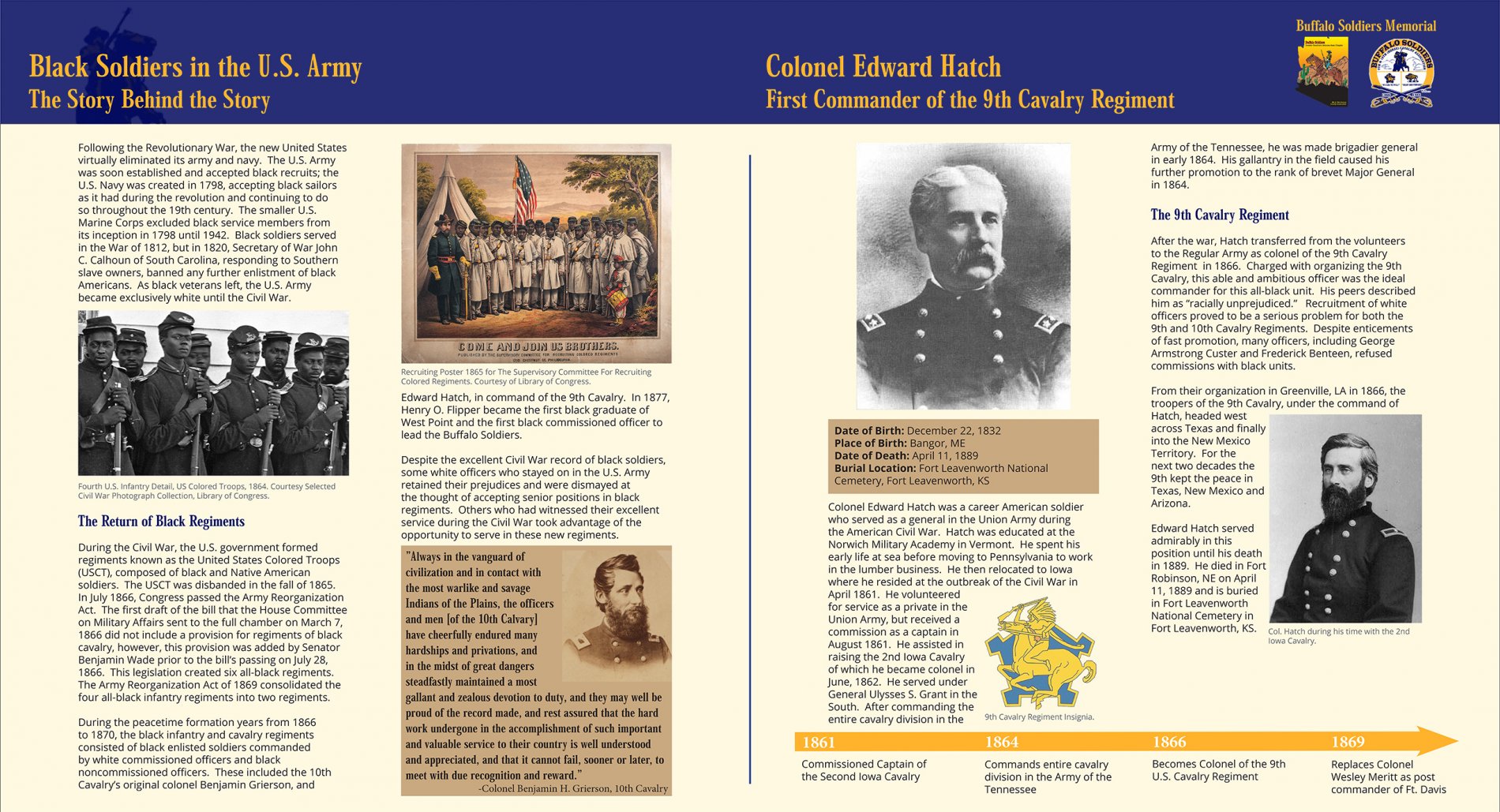Their Stories - Our History
Buffalo Soldiers Background – Six Regimental Units Activated
Over 180,000 Black Americans served in the Union Army and Navy during the Civil War. More than 33,000 died. After the war, the future of the Black soldiers in the US Army was in doubt. However, in 1866 Congress authorized, for the first time, Black Americans to serve in the peacetime army of the United States. Two cavalry and four infantry regiments were created and designated the 9th and 10th U.S.. Cavalry regiments and the 38th, 39th, 40th, and 41st U.S. Infantry regiments were activated on July 28, 1866. The four infantry regiments later became the 24th and 25th Infantry regiments. The all-Black American regiments, commanded mostly by white officers, were composed of Civil War veterans, former slaves, and freemen.
Buffalo Soldiers played a major role in the settlement and development of the American West. After serving in most of conflicts against bandits, renegades, and Native Americans throughout the western United States, several units moved to Arizona at such posts as Ft. Bowie and Ft. Verde in the 1880’s. As protectors of the southern border and the New Mexico Territory including Arizona, Buffalo Soldiers created the atmosphere to establish Arizona and New Mexico as states.
While stationed at Fort Huachuca, AZ, Buffalo Soldiers:
- Protected traffic on the San Antonio-El Paso Road
- Protected Native American Indian reservations
- Protected settlers and guarded stage stations
- Participated in campaigns during the Indian Wars
- Constructed roads and telegraph lines
- Maintained law and order along the US-Mexican Border
Also, all four regimental units (9th and 10th Calvary and the 24th and 25th Infantry) were garrisoned at Fort Huachuca, AZ at one time or another. Fort Huachuca is the only military installation to have this distinction.
In the spring 1916, Buffalo Soldiers and Major Charles Young (one of only six black officers in the Army at the time) were called upon to join General “Black Jack “Pershing in his pursuit of Pancho Villa into Mexico after his attack on Columbus, NM. This became known as the “Punitive Expedition of 1916.”
In January 1918 Buffalo Soldiers defended ranchers from incursions by the Yaquis just west of Nogales, AZ in one of the last battles of the Indian wars in the continental United States.
Throughout the period of the Indian Wars, about twenty (20%) of the U.S. cavalry troopers were black soldiers, while eight (8%) of the infantry were black soldiers. These black soldiers rose above the challenges of harsh living conditions, difficult duty, and racial prejudice to gain a reputation of dedication and bravery.
Buffalo Soldiers were known to have played a significant historical role in at least six National Park Service Units in the American Southwest:
- Fort Davis National Historic Site (N.H.S.), TX
- Guadalupe Mountains National Park, TX
- Fort Larned N.H.S., KS
- Fort Bowie N.H.S., AZ
- Chiricahua National Monument, AZ
The Buffalo Soldier units were disbanded in 1948 when President Harry Truman signed Executive Order 9981 integrating the military services.
Behind the Nickname "Buffalo Soldiers"
According to the Buffalo Soldiers National Museum, the name originated with the Cheyenne warriors in the winter of 1867. The actual Cheyenne translation was "Wild Buffalo." However, writer Walter Hill documented the assertions of Colonel Benjamin Grierson, who founded the 10th Cavalry regiment, who recalled an 1871 campaign against the Comanche tribe. Hill attributed the origin of the name to the Comanche based on Colonel Grierson's assertions. Some sources contend that the nickname was given out of respect for the fierce fighting ability of the 10th cavalry. Other sources say that Native Americans called the black cavalry troops "Buffalo Soldiers" because of their dark curly hair, which resembled a buffalo's coat. Still other sources point to a combination of both legends. The term Buffalo Soldiers became a generic term for all African-American soldiers. It is now used for U.S. Army units that trace their direct lineage back to the 9th and 10th Cavalry, units whose service earned them an honored place in U.S. history.


